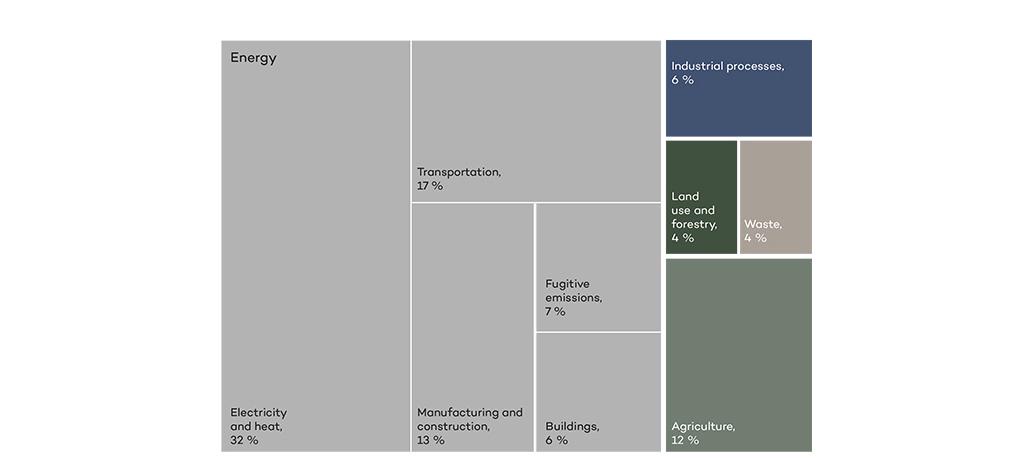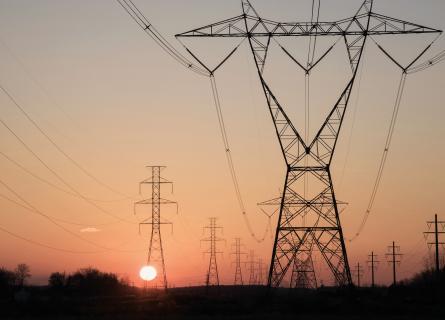
Decade of action
Climate risks can no longer be ignored.
The latest report from the UN's Intergovernmental Panel on Climate Change issued a strong warning that current action is causing irreversible damage, and significant investments are needed to mitigate the crisis. The statement stresses the need for urgent technological and financial reform and business re-engineering.
A global net zero scenario would require transformational changes across all business sectors, the energy ecosystem and the global economy.
Emission reductions and the transformation of current energy systems require annual investments in the magnitude of 1 to 1.5% of global GDP annually. The IPCC estimates in its 1.5°C Report that by 2035, 2.5% of the global GDP will have to be devoted annually to sustainable energy-related investments, of which more than a third constitutes additional net investment needs.
Therefore, businesses must reduce greenhouse gas (GHG) emissions wherever possible. Part of the global challenge is defining responsibility for the generation of GHGs. The level of influence and control each company has over emissions through the value chain is divided into three scopes.
While we have long seen a wide range of concrete action in business for owned and controllable emissions (known as Scope 1 & 2 emissions), less attention has been paid to reducing the so-called Scope 3 emissions along the whole value chain.
Despite the challenges of addressing indirect emissions, Scope 3 not only has a huge potential to prevent the worst impacts of climate change, but it can also lead to substantial business benefits, new partnerships, innovations and revenue growth.

Transformational change needed
Together, energy generation and use account for about 75% of global GHG emissions, including the sectors' emissions (Scope 1 & 2) and downstream in the value chain (Scope 3).
However, as reflected in Scope 1 & 2 reporting, the direct responsibility accounts for a relatively low share of 1/3 of total emissions.
Hence, most businesses do not have insight into the magnitude and nature of their Scope 3 emissions.
Governments have a key role in implementing standards, regulations and incentives to support the decarbonisation of Scope 3 emissions. This support is currently happening in the US and the EU. In parallel, companies working to reduce Scope 3 emissions can mitigate risks within their value chains and unlock new innovations and collaborations while responding to mounting pressure from investors, customers, and civil society.
Key areas of action
Companies that successfully build new coalitions and partnerships, with a shared ambition to reduce emissions, reinvent business models and innovate new products and services, will be better positioned to capture future growth.
Efforts on multiple fronts can create a virtuous cycle where every company actively works to reduce emissions in their value chain while benefitting from other companies' actions. The combined efforts also create more robust data on base targets and performance tracking and help to develop innovative solutions built upon a value chain system's perspective.
Business model innovation
Companies can shift to or create new innovative business models to reduce their Scope 3 emissions substantially. Reconsidering what a specific company can offer, and how it can be offered at a systematic level, can help it meet marketplace demands and generate revenue in new ways while reducing emissions across the value chain.
Emissions performance can also be assigned a monetary value by putting an internal price on carbon that covers Scope 3 emissions. A carbon price can also be used to collect fees that can then be reinvested in new low-carbon activities, products and services. A carbon price can cover both upstream and downstream emissions. It can also financially quantify the environmental performance of products or services relative to those of a company's competitors.
According to CDP, nearly 1,400 companies were already factoring an internal carbon price into their business plans in 2017. The list includes over 100 Fortune 500 companies with approximately USD 7 trillion in annual revenues.

Circular business models
Creating successful and profitable business models that reduce the promotion of unnecessary consumerism and decrease material demand is much needed. Product service systems, for example, provide services and products for collaborative consumption to reduce environmental impact.
Redefining the way we think about product ownership by sharing eliminates the aforementioned emissions associated with new products. Belongings can remain idle for long periods, e.g. the average European car is in use only for 2% of its lifetime.
New technologies – change enablers
"Fourth Wave" technologies such as data analytics, smart sensors and blockchain will help companies manage their Scope 3 impacts by offering powerful insight into complex global value chains and will help reduce emissions in new ways. These technologies play an increasingly important role in business innovation, and business executives agree that implementing new technologies will improve their company's environmental footprint and bottom line.
From product to service
Among the most powerful tools for a company to mitigate its Scope 3 emissions is to focus on lowering lifecycle GHG emissions already during the design of products and services. The design process can play a crucial role in defining the range of reductions in GHG intensity that can be achieved.
Several factors need to be considered when the goal is to design products that can be manufactured using a specific material. These include the possibilities to lower embodied GHG emissions and processing emissions, the range of options for upstream and downstream logistics, the optimum possible use phase efficiency and the feasible end-of-life treatments, which are all invariably determined by the design choice.
A circular economy approach can greatly improve environmental performance by redesigning systems and business models to reduce upstream and downstream emissions simultaneously. According to Material Economics estimates, a circular economy could reduce up to 3.6 billion tonnes of heavy industry CO2 per year globally.
Engagement
Customer engagement is essential for reducing downstream emissions, which companies seek to deliver in many ways. However, successful businesses also partner with clients by innovating new products and services to reduce emissions. In addition, it's becoming more and more frequent to help consumers understand how to reduce their energy usage and individual carbon footprints.
Many businesses invest in low-carbon projects and companies and resilient development, such as transformational, interconnected technologies and solutions to support their pathway to net zero; renewable energy, carbon storage/CCS, clean hydrogen and battery storage.
The challenge ahead
The world's population is estimated to reach 10 billion by 2050. 68% are expected to live in urban areas, and the growing population will expect to see improved living standards. It is not difficult to understand that a larger and more affluent population will want to consume more, putting increasing pressure on scarce resources like land, water and energy.
COP27, the annual UN climate conference, is taking place in Sharm el-Sheikh, Egypt, on 6-18 November 2022. The conference represents what is likely to be the final opportunity to take global collective action on the climate crisis and achieve net zero emissions across the economy, in line with the Paris Agreement.
Governments and companies must lead the way to mitigate climate change, adapt to it and provide livable conditions for the global population. Reducing Scope 3 emissions and partnering up with suppliers and customers is critical for all business leaders who aim to manage responsibly and simultaneously create societal value.
Now is the time to act.
Authored by: Kjetil Ingeberg and Helena Mueller



